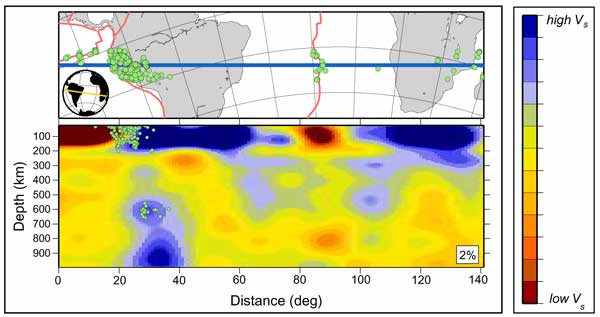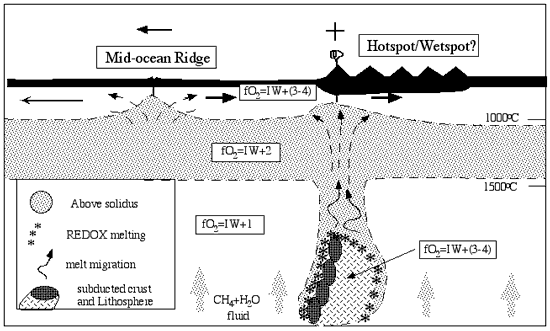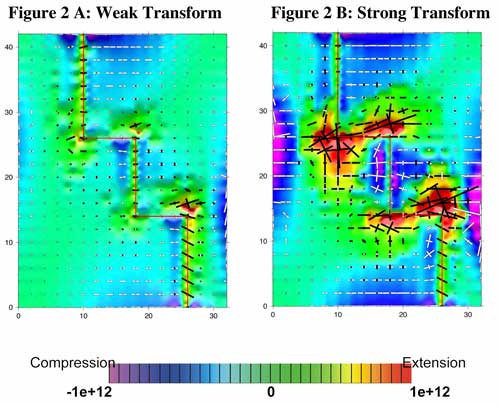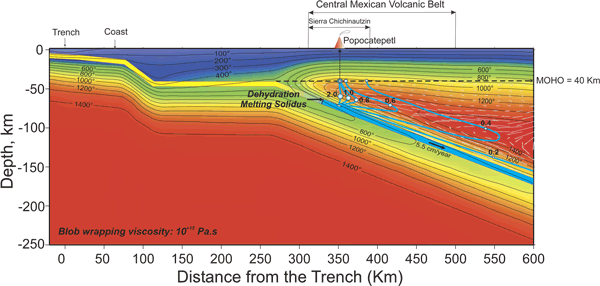
Penrose Conference
Plume IV: Beyond the Plume Hypothesis
Tests of the plume paradigm and alternatives
Scientific report: Web version
|
|
Penrose Conference Plume IV: Beyond the Plume Hypothesis Scientific report: Web version |
In Iceland we experts on plumes,
Convene amidst lava and fumes.
We huddle together
In inclement weather
And what we don't know we assumes.
– Wolfgang Elston
Can “hot spots” – regions of anomalous volcanism – be explained by mechanisms other than deep thermal upwellings? This question was the subject of a week-long debate at the Penrose Conference, Plume IV: Beyond the Plume Hypothesis, which was held August 25-29, 2003 in Hveragerdi, Iceland. Over 60 geologists, geophysicists, and geochemists from 12 nations, including 8 students, gathered to go back to basics and brainstorm the fundamental evidence that constrains the origins of volcanism. Evidence from seismology, convection modeling, heat flow, geothermometry, petrological laboratory measurements, geochemistry, radiometric dating, kinematics, morphology and a great deal of basic geology was considered. This meeting was the most significant gathering ever held of scientists working on alternative mechanisms for volcanism. Other meetings will follow.
Figure 1: Tomographic cross sections through Iceland (for more details, see Foulger et al., 2003). |
State-of-the-art results from seismology were presented, including wave propagation, tomography and anisotropy, along with tutorials and summaries of what seismology does and does not, can and cannot, tell us. Contrary to popular expectations, seismic wave speeds beneath Hawaii are relatively high (Julian). Whole-mantle tomography favours strong impedence of flow across the 660-km discontinuity and a relatively homogenous middle mantle (Dziewonski). Tomographic evidence for slab penetration through the entire mantle to the core-mantle boundary has been widely inferred, but the evidence is sparse and questionable and detailed scrutiny reveals problems with these interpretations. Study of anisotropy may reveal the orientation of flow beneath volcanic regions (Montagner). Credible seismic images of low-velocity bodies traversing the entire mantle, as predicted by hot upwellings from the core-mantle boundary, are lacking. Low-velocity bodies extending down to the transition zone have been found beneath a few volcanic areas including Iceland and Eiffel, but similar bodies have also been found beneath non-volcanic areas such as Brazil and the Ontong-Java plateau (Foulger, Wilson). The interpretation of high- and low-velocity anomalies is ambiguous (Anderson). Discussion emphasised that melting, mineralogy, composition, anisotropy, dehydration and temperature variations are all candidate explanations for seismic wave-speed anomalies, with temperature having a relatively small effect. A serious problem for seismic work in many regions is scarcity of ray-path data that results from the uneven distribution of earthquakes and seismic stations, especially in the Pacific ocean (Dziewonski). This may produce spurious features in tomographic images. This situation could improve in future if large numbers of ocean-bottom seismometers are deployed (Montagner). |
Convection modeling, which requires constraints from mineral physics, can explore the mode of convection within the Earth, whether it is layered or whole-mantle, whether thermal plumes are likely to form and if so, what form they take (Ihinger, King). Early, simple investigations involving either laboratory experiments with tanks of liquids or numerical models have been strongly influential in shaping popular qualitative concepts of plumes and have led Earth scientists specialising in other sub-disciplines. However, Earth is radically different from a tank of liquid in a laboratory, and is not realistically modeled by approximations such as ignoring the depth, temperature and pressure dependence of rheology, thermal conductivity and the coefficient of thermal expansion, the temperature dependence of viscosity, the sphericity of Earth, internal heat sources and the existence of plates (Anderson). The most sophisticated lower-mantle models to date predict a few vast, sluggish upwellings rather than many localised plumes, but these models still neglect critical factors such as temperature-dependent viscosity, thermodynamically consistent parameter variations, and non-uniform internal heating (King). The Earth is probably chemically layered (Anderson, Hofmeister). This view is supported by cosmochemistry, petrology, dynamic topography, mineral physics, pressure, temperature the inferred difference in grain sizes in the upper and lower mantles, seismic velocity profiles in the transition zone, the absence of surface samples of rocks from deeper than the transition zone, and modeling of the distribution of radioactivity and the thermal profile of Earth. Mantle avalanches may explain catastrophic periods of volcanism such as occurred in the Cretaceous (Hofmeister). Catastrophic changes in global stress and plate tectonics may also becaused by lithospheric dynamics (Anderson).

Figure 2: Cross section through seismic tomography model S20RTS showing possible EDGE convection structures (for more details, see King, 2003).
It is generally assumed that “hot spots” are hot. They are of course hot in the sense that volcanic activity occurs at the surface, but the important question that bears on the origin of this volcanism is the relative potential temperature of the mantle beneath. This subject was critically examined in three sessions that focused on heat and temperature. Marine heat flow measurements provide little evidence for enhanced heat flow around “hot spots”. Two spectacular examples of this are Hawaii and Iceland where heat flow measurements provide no evidence for sub-lithospheric temperatures significantly higher than average or for the expected migration of the loci of heat. Such findings are typical of most “hot spots” (C. Stein).
Experimental studies consistently point to low solidus temperatures for mantle materials containing likely amounts of water or carbon. The ubiquity of CO2 and H2O in volcanic glass from spreading ridges and islands suggests that the seismic low-velocity zone beneath oceans may result from the presence of incipient melt since the presence of volatiles significantly lowers the solidus temperature in adiabatically ascending mantle material compared with the dry solidus (Green, Presnall). It thus produces more extensive melting at lower temperature at any given depth. This suggests that either mantle composition or mantle potential temperature is mapped by the topography of the low-velocity zone. Through subduction, other materials besides peridotite such as recycled ocean crust (coesite eclogite), which has both lower solidus and liquidus temperatures, are constantly re-introduced to the mantle. These materials allow melting at lower temperatures than needed for peridotite alone (Green). The importance of picritic magmas in both MOR and “hot spot” locations was a significant issue, as the temperatures of primitive magmas are the most direct evidence of mantle potential temperatures (Green, Presnall). Parental picritic magmas were proposed for both Hawaiian and MOR settings (N-MORB and E-MORB) leading to inference of similar mantle potential temperatures (Green). Liquidus spinels and harzburgite-residue trends for Hawaiian picrites indicated a more refractory (in major elements) but refertilized (incompatible elements) source, and more refractory residue, than MORB. The role of picrites in MOR settings was challenged and parental MOR magmas comprising olivine tholeiites at ~150°C below the temperature of “hot spot” picrites was advocated (Fitton, Gudfinnsson, Presnall). This debate highlighted the question of whether “hot spot” magmas must be derived from a thermal boundary layer or whether they may be derived from compositional inhomogeneities in the so-called “convecting mantle” i.e., the adiabatic regime. If the latter, some source temperature variations may result at least partly from variable depths of origin in the conductive layer, rather than from lateral variations of potential temperature.

Figure 3: Cartoon suggesting a model for intraplate “hot–spot” volcanism attributing the primary cause of the melting anomaly to a compositional anomaly within the mantle beneath the asthenosphere, i.e. > 150–200 km depth (for more details, see Green, 2003).
Many presentations focusing on specific localities explored genetic mechanisms that were linked to plate tectonics, and in particular to continental breakup and collision – the start and end games of plate tectonics. The great melt volume in the North Atlantic Volcanic Province and Iceland was attributed to mantle fertilised with subducted Iapteus crust (Foulger). The Central Atlantic Magmatic Province (CAMP) includes dikes that follow stress patterns related to Pangaean rifting, and requires widespread mantle source regions and extraction of melt from different depths (Mangas, McHone). This province is best explained by widespread, shallow, small-scale convection. The breakup of the South Atlantic was accompanied by intense volcanism that persisted at some locations e.g., the Walvis and Rio Grande ridges, which recent, highly detailed gravity data show have structure that suggests control by variable lithospheric stress. The source of these variations may be large-scale internal deformation and stress redistribution within the African plate, resulting from changes in its plate-tectonic boundary conditions (Wilson). Transform zones, both submarine and exposed in ophiolites, are important both in controlling stress (Beutel) and in faciliating particular experiments by presenting the opportunity to collect data that cannot be retrieved from ridge segments (Bonatti, Chalot-Prat). Intense magmatism at the onset of breakup may be a result rather than a cause of breakup, and magma ponding prior to breakup may be a significant factor (Anderson).

Figure 4: Compressive and extensional stresses at ridge-transform junctions for a weak and a strong transform (for more details, see Beutel, 2003).
Figure 5: Model for the commencement of volcanism, at ~ 17 Ma, that developed into the Yellowstone-Snake River Plain system (for more details, see Christiansen & Lageson, 2003). |
Discussion of continental
magmatism focused on tectonic associations,
the relationship with continental collision and break-up and the sources
of geochemical components in the magma (Barry, Christiansen,
Chalot-Prat, Chamberlin, Finn, Flower, Peccerillo, Wilson).
Continental magmatism is often, but not always,
closely associated with subduction, old sutures or major lithospheric
structures such as rifts. The Yellowstone magmatic system initiated
above a subducting slab, in a backarc setting. This suggests it is of
shallow origin and may result from backarc edge convection at the margin
of the Archean craton to its north (Christiansen). |
Widespread volcanism occurs in Italy, the site of recent and current subduction, and there the geochemical and isotopic characteristics suggest relationships to lithospheric structure, shallow processes, and an origin for the EM1 and EM2 components in recycled subducted upper crust (Cigolini, Peccerillo). A similar model could explain volcanism throughout the Tethyan region (Flower). There are, nevertheless, still examples of continental volcanism where associations with candidate causative lithospheric features are not obvious, e.g. in Europe and Mongolia (Barry, Fekiacova, Wilson).
Extraterrestrial volcanism can potentially increase our understanding of volcanism on Earth. Neighboring Venus has no plate tectonics, and its heat budget and thermal history are poorly constrained. The planet is widely regarded as having been wholly resurfaced, during a brief or prolonged event ending perhaps 500 Ma ago, by magmatism due to extrusive and sublithospheric plumes. The deduced behavior of these may aid understanding of terrestrial volcanism (Smrekar, Stofan). The plumes may have been localized in part by distributed rifting (Jurdy). These inferences assume heat productivity similar to that of Earth, and imply episodic overturns of the Venusian mantle. Alternatively, the large to huge (> 2000 km) rimmed circular structures, many of them multi-ringed, may instead be impact craters dating from the main accretion of the planet, before 3.9 Ga. Material water-eroded from them may have been deposited as turbidites, partly burying low-lying crater-saturated terrain, in an early transient ocean (Hamilton). The cold Venusian mantle required by this interpretation may reflect a very low global content of volatile potassium, which is supported by the observation that the inner Solar System displays strong heliocentric compositional zonation, elements and compounds of progressively higher condensation temperatures decreasing sunward.
Geochemists reconfirmed that Sr-, Nd-, Pb-, and He- isotopes cannot be used to estimate a depth of origin or volume for mantle sources. Connections have been made between He isotopes and FOZO or the common “C” component in island isotopic systematics, but the requirement that FOZO and other enriched components (EM1, EM2, HIMU) must come from the deep mantle was questioned (Natland, Smith). Enriched basalts are widely distributed over thousands of seamounts, they are not confined to the tops of islands in linear chains, and plume sources cannot explain them all. Os isotopes have been interpreted to mean that a core component may be present in picritic to komatiitic basalt from Hawaii and Gorgona (Walker) but this is non-unique and could reflect instead a metamorphic, pyroxenitic or other component (Anderson, Smith, Walker). The chondritic pattern of trace siderophiles suggests isolation of the upper mantle from core interactions. W-Hf isotopic systematics may soon offer a means of determining whether a signal from the core-mantle boundary ever reaches the Earth's surface (Anderson).
Figure 6: Na8 contents of Icelandic basalts and crustal thickness (see also Natland, 2003). |
|
Field associations suggest a heterogeneous upper mantle over which ridges migrate (Bonatti, Dick, Natland). The upper mantle seems to contain variably fertile to barren lherzolite and harzburgite, associated on scales varying from hand-specimen-sized domains to subducted, abandoned masses of partly altered ocean crust converted to eclogite (Natland). Also present is the subjacent abyssal peridotite, pyroxenite produced by reaction between peridotite and migrating melts, and variably distributed masses of former terrigenous and marine sediment carrying quartz, water, and carbonate – some of it reconstituted to high-pressure assemblages. Abandoned blocks of continental crust with subjacent lithosphere, isolated during continental rifting, now reside in the middle of ocean basins. Rifting cannot cleanly have severed these from the larger continental masses, and some subcontinental mantle may be incorporated in basaltic magma generated in new ocean basins (Natland, Smith). The scale of heterogeneity produced at spreading ridges is later re-imposed on the mantle at subduction zones, with sedimentary components added.
Slabs trapped in sutured subcontinental lithosphere by continental collision could provide a source of magma during subsequent continental breakup. Young, thin slabs may be neutrally buoyant in shallow mantle and be passed over by migrating plates. A melting domain beneath an island or a ridge cannot be represented by a single mantle lithology, as isotopic variability assuredly indicates. That variability consistently points to involvement of source materials that formerly interacted with the Earth's atmosphere and hydrosphere and are readily subject to partial melting upon reheating at any depth in the mantle (Manea, Natland).

Figure 7: Thermal, mantle wedge flow and blob tracing models for the Central Mexican Subduction Zone. Melted magma may accumulate along a subducting plate and produced detached blobs with lower density and wrapping viscosity than the surrounding mantle.Blobs bigger than ~ 0.8 km reach the Moho below strato-volcanoes, while the blobs smaller than ~ 0.8 km reach the crust at some distance from stable volcanic features, depending on the blob size. Blob trajectories seem to be related to the numerous monovolcanic cinder cones (see also Manea, 2003).
Melting models based on an homogeneous peridotite source that vary only the extents of partial melting, crustal thickness produced, and mantle temperature are too simple. Iceland, for example, is compositionally anomalous in so many respects that an unusually fertile mantle source, perhaps including a substantial body of eclogite that was originally ocean crust, may be required to explain both the geochemistry and the crustal thicknesses there (Foulger, Natland). Indeed, the seismic crustal thickness beneath Iceland is variable and its interpretation in terms of melt thickness is still controversial (Björnsson, Foulger). The scarcity of evidence for excessive mantle temperatures (Green, Gudfinnsson, Presnall, C. Stein) encourages consideration of source variability (Natland). Models that involve fertile, low-melting patches and lithospheric stress may thus provide viable alternatives to localized high temperature for many volcanic regions.
Can deformation and flow at plate boundaries or within plates induce volcanism? The plate-tectonic ideal wherein plates are truly rigid and cannot deform breaks down in reality. Plates move coherently but are not completely rigid, and thus cracks and volcanic chains can form without disrupting the first-order coherency of plate-like motion (Anderson, Natland, Smith, Winterer). The Pacific plate may be affected by changes in subduction geometry such as annihilation of ridges at trenches, which change plate-wide stress. Can such stresses produce lithospheric fractures that propagate across the seafloor, and along which basaltic magma can erupt? Examples of mid-plate volcanism apparently controlled by tensional fractures were cited, and correlations between seafloor volcanism and subduction geometries. Mesozoic Pacific volcanoes were widely scattered, without age progressions, and not arranged in linear chains. As the Pacific plate grew and circumferential ridges encountered subduction zones, the linear Line and Gilbert seamount chains developed, though there is no age progression in the Line chain.
This unexpected scattered magmatism could be related to shear heating generated by the “westward” delay of the lithosphere relative to the mantle, the so-called westward drift of the lithosphere. This is supported by the asymmetry of subduction and rift zones worldwide. Moreover shallower and mobile hotspots result in a faster (> 50 mm/yr) net rotation of the lithosphere being calculated. Along viscosity asperities in the asthenospheric decoupling zone, the shear heating could locally determine a temperature increase > 130° C, and be able to trigger local partial melting and related intraplate Pacific magmatism (Doglioni). Figure 8: Model of preferential lifting of the eastern sides of ridges (see also Doglioni, 2003). |
|
As continental collisions accompanied the close of Tethys in the Eocene (Flower), the western part of the Pacific plate became largely bordered with subduction zones. Since the time of the Hawaiian-Emperor bend, much seamount and island volcanism on the plate has been linear, age progressive, and parallel. The bend itself does not record a substantial change in direction of the Pacific plate, as may clearly be seen from the continuity of spreading patterns and transform zones at this age (Hamilton) but may represent a change in the orientation of stress imposed on the plate from its edges. Earth was clearly very different in the Mesozoic than in the Cenozoic.
Various aspects of the distribution of volcanism in the Pacific were cited in support of the desirability of considering new models. Linear chains, especially where not time-progressive, point to tears in the plate or eruption along pre-existing structures (Geist, Harpp, O'Connor). The most credible non-thermal model for the Emperor-Hawaiian chain is a propagating crack related to stress in the plate. Much plateau formation was associated with triple junctions (Smith). Finite-element modelling of ridge-transform junctions reveals an intrinsic pattern of extensional stress that encourages volcanism (Beutel). In the south-west Pacific, the small magma volumes, lack of association with rifting, lack of uplift and broad areal distribution need to be explained by causative models. Episodic plate reorganization and the recycling of metasomatized lithosphere from subducted slabs may be involved (Finn).
Figure 9: The Ontong Java plateau showing locations of drill sites (for more details, see Fitton et al., 2003). |
The Ontong Java plateau,
Shatsky Rise, Kerguelen plateau, Deccan Traps and Bushveld complex are
Large Igneous Provinces (LIPs) that were discussed in detail.
They represent volumes of magma so huge and eruption rates so rapid
that they are a problem to explain by any process, although recent dates
tend to indicate longer emplacement times than once thought at some
LIPs (Pringle, Sheth). Distributed eruption or flow over long
distances internally inside lava sheets is required to explain the huge
areal sizes of flood basalts (Sheth). Diverse origins were proposed.
The uniformity and major element geochemistry of Ontong Java plateau
basalts was cited as supporting a plume origin and ruling out the involvement
of eclogite (Fitton). The lack of evidence for precursory uplift,
and the existence of magnetic stripes across the plateau remain unsolved
problems in this model, as does the lack of evidence for fertility in
models based on source heterogeneity. Ponding of magmas prior to eruption
may be responsible for magma homogeneity (Anderson, Foulger). |
Shatsky Rise, another Pacific volcanic plateau, is clearly shown by magnetic stripes to have formed at a migrating triple junction (Sager). The Kerguelen plateau contains continental crust and had more prolonged magmatism than some other LIPs (Pringle). A model for the Deccan Traps was presented that linked them to sutures and proposed a source in recycled ecolgite trapped in ancient sutures. Amongst evidence cited against a thermal origin was the lack of evidence for high temperatures in the petrology and the lack of precursory uplift (Sheth), features that are also shared by the continental Columbia River Basalts, that formed in a back-arc environment (Christiansen). A multiple bolide impact origin of the Bushveld Complex, which is supported by evidence for ultra-high temperature debris flows and intense deformation, is the proposed trigger for mantle upwelling and decompression melting of upper mantle and crust there (Elston). The possibility of long-term, sub-lithospheric magma ponding, leading to voluminous bursts of volcanism was posed to explain volumes and eruption rates (Anderson). The absence of LIPs at the ends of many linear volcanic chains e.g., the Emperor chain, and the lack of linear chains emanating from many LIPs, e.g., the Ontong Java plateau, brings into question the traditional “plume head – plume tail” model. The classic example of a plume head-tail, the Deccan Traps – Chagos – Laccadive Ridge – Reunion Island, was questioned, and the Chagos – Laccadive Ridge ascribed to melting and melt focusing along a southward propagating fracture in the Indian plate (Sheth).
An exciting diversity of ideas and concepts was presented at the conference, along with a healthy infusion of skepticism and challenges. In the case of volcanic regions where evidence for unusual heat is lacking, source fertility and volatiles, recycling of subducted slabs or continental lithosphere, intraplate deformation localised along faults, fractures, rifts and sutures, stress variations and bolide impacts are promising avenues to consider. It is clear that these models cannot be entertained without re-evaluating other aspects of how we view our planet, such as the interpretation of seismic anomalies, the effect of convection on the upper mantle, temperature, the longevity of shallow heterogeneities, the importance of lithospheric stress and structure, the origin of geochemical tracers, the fate of subducted slabs and the melt-retention capabilities of the mantle. In the case of volcanic regions where there is evidence for anomalously high temperature, a better understanding of the origin of this is required, including its depth of origin and the physical basis of any convection that may be occurring. There is growing awareness that, despite many decades of modern work, there is much that is still poorly understood about volcanic regions, poorly explained by current models, and not quantified. Critical data such as seismic measurements from the oceans, heat flow, radiometric dates, petrological laboratory data and basic maps are lacking. Required methodologies such as geothermometry, detection of deep components by seismology and geochemistry and thermodynamic modeling of mantle convection are still too primitive to answer the critical questions that need to be answered, and much work remains to be done.
The Penrose conference brought together for the first time many of those who are curious about the origin of volcanic regions. The full range of ambient ideas in this embryonic field were laid out, brainstormed, criticised and challenged. The problems, needs and tasks ahead were brought into focus, and it is clear that we are at the start of a long and exciting journey.
Participants were : Don Anderson, Tiffany Barry, Erin Beutel, Axel Bjornsson, Enrico Bonatti, Francoise Chalot-Prat, Richard Chamberlin, Bob Christiansen, Corrado Cigolini, Marc Davies, Henry Dick, Carlo Doglioni, Adam Dziewonski, Wolfgang Elston, Zuzana Fekiacova, Carol Finn, Godfrey Fitton, Martin Flower, Gillian Foulger, Bjarni Gautason, Dennis Geist, David Green, Gudmundur Gudfinnsson, Giuseppe Guzzetta, Warren Hamilton, Karen Harpp, Anne Hofmeister, Dorthe Holm, Fredrik Holm, Gregory Huffman, Phillip Ihinger, Sveinn Jakobsson, Leonard Johnson, Bruce Julian, Donna Jurdy, Scott King, Vlad Manea, Marina Manea, Jose Mangas, Greg McHone, Jean-Paul Montagner, Jim Natland, John O'Connor, Angelo Peccerillo, Emma Perez-Chacon, Brian Pope, Malcolm Pringle, Dean Presnall, Will Sager, Hetu Sheth, Olgeir Sigmarsson, Alan Smith, Suzanne Smrekar, Carol Stein, Seth Stein, Ellen R. Stofa hard Walker, Phil Wannamaker, Dayanthie Weeraratne, Marjorie Wilson, Jerry Winterer and Don Wright.